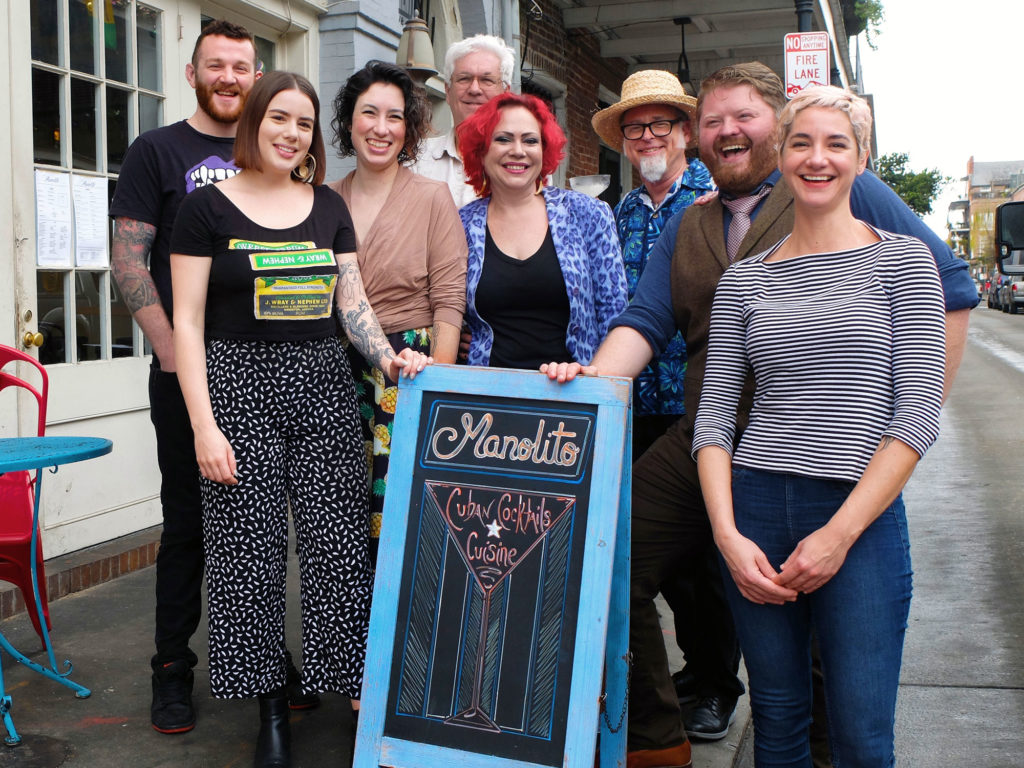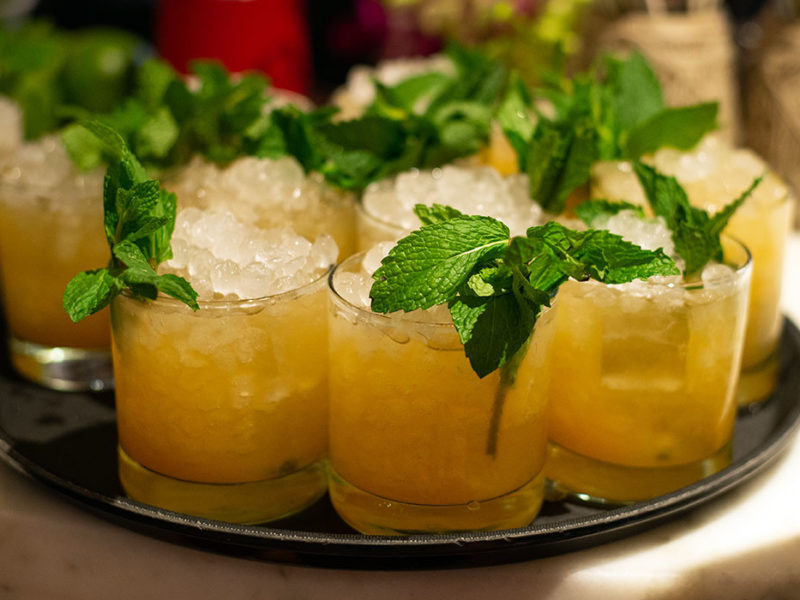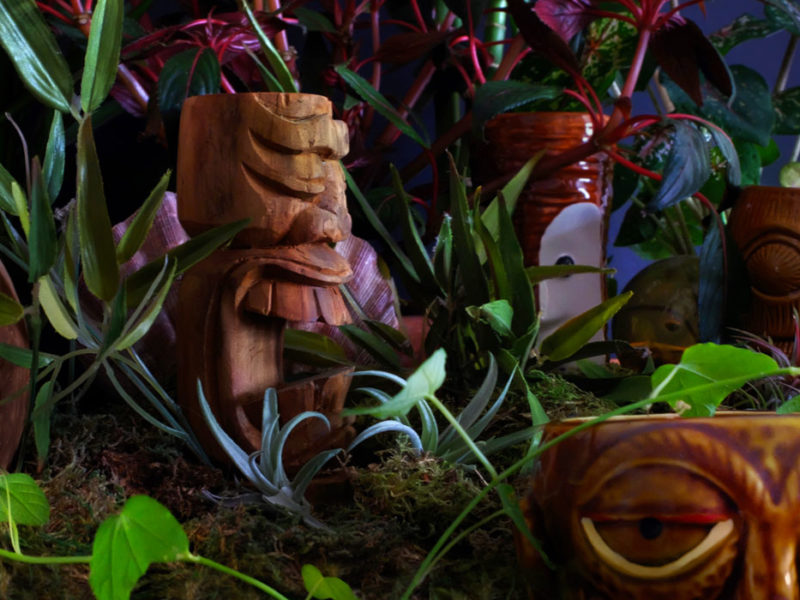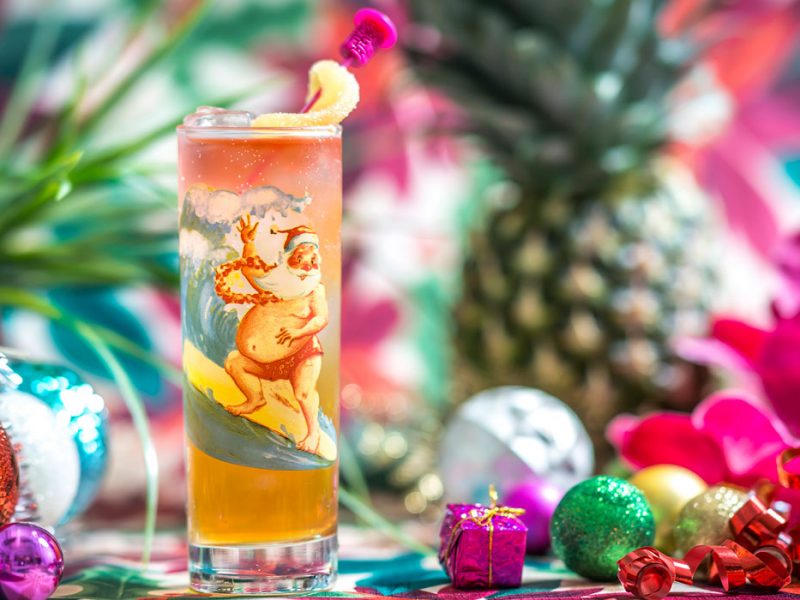After our first Daiquiri Symposium at Death & Co. in New York in May 2018, it became clear that the Daiquiri was an inspiring topic for just about everybody in the bar industry, and that our symposia were bound for glory, fixing to criss-cross the United States and pose Daiquiri-based imponderables to bartenders and historians from Bangor to Kihei.
On February 4, 2019, a new crack team assembled for round two in New Orleans, at Manolito—the only Daiquiri bar in a town full of Daiquiri bars. The special relationship between New Orleans and the Daiquiri—not to mention Cuba—would be explored by some of its top bar minds.
Nick Detrich served as moderator and our host at Manolito, an homage to the legendary Cantineros of Cuba, which he opened with just-about-as-legendary partner Chris Hannah.
Jeff “Beachbum” Berry is the author of seven award-winning books on tiki drinks and the owner of Beachbum Berry’s Latitude 29, a New Orleans bar-restaurant which Esquire and Playboy named one of the U.S.A.’s best bars. This is correct.
Wayne Curtis refers to his calling as “designated drinker” in addition to freelance journalist and contributing editor. His book And a Bottle of Rum shepherded in a new appreciation of the stuff.
Liam Deegan is a certified cicerone and managing partner of Longway Tavern, which focuses on French Quarter classics.
Jen Hussey got her start in cocktailing at Drink in Boston. She is now behind the bar at Justine in the French Quarter.
Maggie Morgan has tended bar in New York, Hong Kong, and across New Orleans at Meauxbar, Cane & Table, and Manolito, and can now be found at Jewel of the South, Detrich and Hannah’s latest project.
Kimberly Patton-Bragg is a bar industry veteran with many accolades under her belt. Perhaps the most iconic is a feature in the cookbook companion to HBO’s Treme.
Josephine Romo has Cuban heritage and over fifteen years of bartending experience, five of those in New Orleans, where she is part of Manolito’s team of Daiquiri specialists.
Thank you to all involved for their substantive and unique contributions, as well as to Sari Lindersmith, who kept the group focused with regular infusions of more Daiquiris. Without further ado, our New Orleans Daiquiri Symposium.
This transcript has been edited for length and clarity. — Ed.
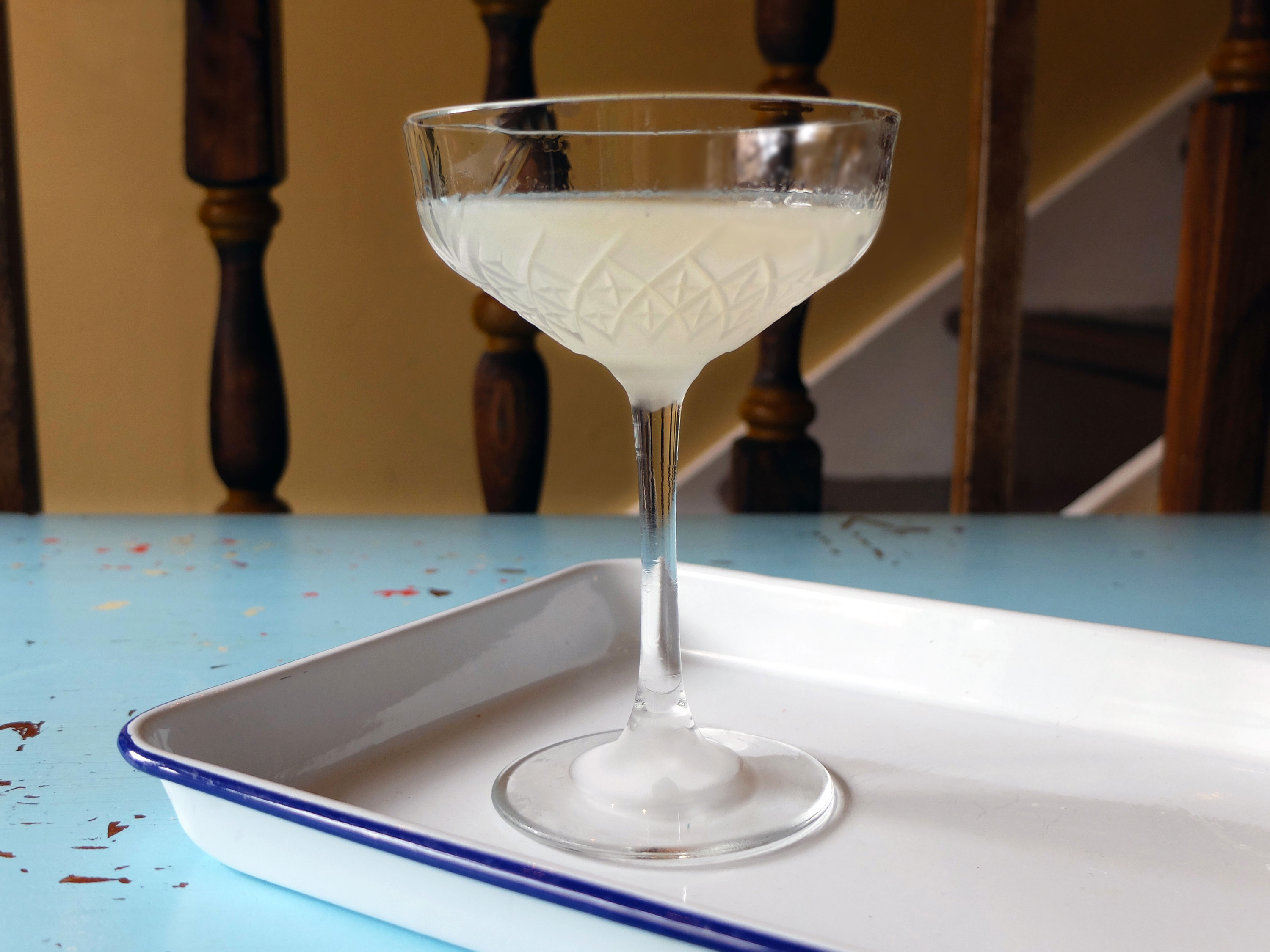
Sugar and Structure
Nick: I want to talk about the anatomy of the Daiquiri. Obviously, it is something with origins that run very deep in the Caribbean, even though it wasn’t properly identified as a Daiquiri until 1903, as one apocryphal story states. And there have been many interrelations of it before.
But as far as the structure goes, I want to discuss what sugar means to the Daiquiri and, more widely, how it introduced sugar to many beverages outside of the realm of the Daiquiri. What the lime juice means; what was used initially; what is used now. Maybe, talk a little bit about scurvy.
Jeff: Why are you looking at me when you say that?
Nick: And then we have to talk about the rum. How significant is Cuban rum? But to kick things off, does anyone here feel strongly about sugar?
Maggie: Somewhat, yeah. When I have a Daiquiri I don’t want it to be too syrupy. I feel that ruins the entire experience. So, if you’re using a super thick, two to one Demerara and you’re also using an aged rum—I don’t want a sugar bomb. I want something that is light and clean and refreshing. So sugar is huge for the Daiquiri because I don’t want something that’s too syrupy but I don’t want something that’s too watered down. Which is why I prefer granulated sugar. It doesn’t add any water or texture really, just sweetness to the drink, which is what it should be.
Nick: By a show of hands, how many people prefer granulated sugar for the Daiquiri? More than half the room. Rich simple, two to one? No one. Simple, one to one? The rest of the room. So, I guess seventy, thirty split for granulated to simple.
Jen: My biggest issue with the granulated is when it’s well done it is very good, but I’ve seen and had so many Daiquiris where someone did it and it never really incorporated. So I’ve just ended up drinking rum and lime juice with a layer of granulated sugar at the bottom. If I’m going to order a Daiquiri, I’d rather see a one to one simple because at least then I know the ingredients would be incorporated. Now, if it’s someone who I trust, like if I was ordering from Maggie, then yeah, I’m happy to see her use granulated sugar because I’d know she was going to do it justice.
Kimberly: I like Demerara sugar in mine, and that wasn’t what I was used to using before, but now I really like adding that richness especially if you’re using a white rum. For something a little funkier like a Jamaican or even an agricole, I like having that richness. But I agree with Maggie, if you’re using an aged, you don’t need molasses on top of molasses on top of molasses, or extra vanilla or any of that kind of stuff.
Whether it’s simple, whether it’s Demerara, I think it depends on your spec for that particular rum. You can make a balanced, aged rum Daiquiri, but you have to really work on how much you’re going to use and what you’re going to use with it.
Maggie: You also have to think about your steps of making the drink. You have to take that second to stir it first before you add ice, because as soon as you add the ice it’s so much harder for the sugar to dissolve, because it bonds to the ice immediately. So you need to take that second to stir really hard, and I feel like with white sugar it just dissolves much faster than a turbinado or a Demerara.
Jeff: I use a sugar mix. It’s evaporated cane juice, four parts, and then one part of a Demerara or turbinado, just to add a little bit of molasses feel into it, because white sugar, organic or not, doesn’t have enough character, really. You don’t want to overwhelm it with a Demerara sugar, but just a bit of that touch of molasses gives it a little more oomph.
Daiquiri by Jeff “Beachbum” Berry
2 ounces 89-proof Cuban white rum, circa 1920s
¾ ounce fresh lime juice
1 rounded teaspoon organic cane sugar (evaporated cane juice)
Dissolve sugar in lime juice in shaker. Add rum. Shake vigorously with cracked ice. Strain into a vintage Trader Vic tiki-stem bevelled cocktail coupe.
Consume up to four of these Daiquiris come early evening, 5 or 6 P.M., whichever enables you to catch the sunset in your time zone. If you can’t drink them in the company of David Wondrich, Wayne Curtis, Greg Boehm, Martin Doudoroff, Gaz Regan, Annene Kaye, or Ben Schaffer, then you can still console yourself with the fact that four of these Daiquiris will make boring people interesting and interesting people scintillating.
Nick: Do you think that using a turbinado or Demerara is better for dilution?
Jeff: It’s worse for dilution. You have to stir for like ten or fifteen seconds, but it doesn’t take any more time to do that than it does to make an Old Fashioned. It’s not a big of a deal. But you can dissolve it completely after like ten seconds in the tin with no ice, and then you add the rum and ice. But speaking to what Kim said, we’ll use that with the white rum, I wouldn’t use that mixed with a darker rum or more molasses-y rum. I would probably go with the simple.
Nick: Yes. Is there any sort of split that you would have between making a Daiquiri for yourself at home and making it at your bar?
Jeff: Yeah, when I make it at home, I just take the sugar right out of the can. I don’t do the mix.
At Latitude we do two level teaspoons of the sugar mix. Dissolve that in an ounce of lime, and then there’s two ounces of an eighty-six proof. We had an eighty-nine one when Bacardí was making that one. But at home, it’s just whatever white rum I’ve got and one rounded teaspoon of sugar and three-quarters of lime. Which is closer to the classic Constante Cuban mix and also gets you fucked up faster.
Wayne: I still have a bunch of your [Manolito] blend that I made over the summer, which is the Caña Brava, El Dorado 3, Smith and Cross. You squeeze half a lime and then I just go a little bit less on the simple syrup than on the lime. The one to one thing is always too sweet so maybe two-thirds to one. Then beat the hell out of it. And if I’m at Uptown I grab a couple of lime leaves off of the tree and throw those in there because you have the oils off of them.
Ian Burrell came up to visit one year and he said, “Let’s make some Daiquiris.” He looked out the window and he said, “Is that a lime tree out there?” And I said, “Yeah, but the limes aren’t in yet.” And he goes, “All right.” He went and got a bunch of leaves, threw ’em in there, and it makes a difference.
Maggie: I feel like you just need that trinity of all three ingredients. I don’t want to have one that’s overpowering the other, but they should all just kind of become this one beautiful thing. I don’t want to taste more sugar, more lime, or more rum, I want all of them to come together in a really special way.
Daiquiri by Liam Deegan
2 ounces rum
1 ounce lime juice
scant half ounce of rich simple for texture
a super chilled Nick and Nora or coupe glass
I have a few different ideas for a Daiquiri. All the specs are the same, however it depends on the mood. On a hot day a cold Daiq with Don Q is just right, but usually just the one before moving on to cold beer.
If I want to have a couple Daiquiris I prefer the dryness of Wray & Nephew, you just have to keep in mind it’s a boozy drink that goes down easy, so, the “one is all right, two is too many, and three’s not enough” rule fits pretty well here.
For something funky, I always love Smith and Cross, and lastly if it’s split into quick shots, Plantation Pineapple.
By Any Other Name
Nick: Would any of you call a rum, lime, and honey drink a Daiquiri?
Maggie: No.
Josephine: It’s a Canchánchara, isn’t it? It’s my favorite.
Nick: So, could you say a Daiquiri by any other name is just a sweet?
Kimberly: I knew you’d say that. I knew the Bard was going to come out eventually.
Nick: How dramatic is the difference between granulated sugar, Demerara sugar, cane syrup, evaporated cane syrup, honey?
Wayne: They’re all in a range, except honey, which is way over here. It takes us to another zone.
Nick: Would you say that’s because of a floral component?
Wayne: It’s a honey component.
Liam: I would say the honey Daiquiri is not a Daiquiri. It falls under the umbrella of a Daiquiri drink. But almost everything falls under the umbrella of a Daiquiri-style drink.
Nick: So, how interchangeable are the three ingredients of the Daiquiri then?
Jeff: Okay, I’ll probably screw this up. I failed philosophy class in high school. All Daiquiris are rum sours but not all rum sours are Daiquiris? It’s all just a matter of classification. If the Daiquiri is defined as rum, lime, and sugar then if you put rum, lime, and honey in it it’s not a Daiquiri.
And that’s the thing that makes Daiquiris infuriating, is if you want to have a drink and call it a Daiquiri you have to make it tasty and it’s not an easy thing to do. It’s like it’s so basic, it’s like the Becky of cocktails. It’s 33% each ingredient. Just three stupid little things, but if you can’t get them all right, it’s like, “Man, I don’t want to finish this.”
Wayne: Yeah, it’s a sort of a test. If you go to a whiskey bar you order an Old Fashioned, tequila bar you get a Margarita, rum bar you get a Daiquiri. You have to take the Daiquiri but the next drink might be a Budweiser if I don’t trust this.
Jen: It’s a litmus test.
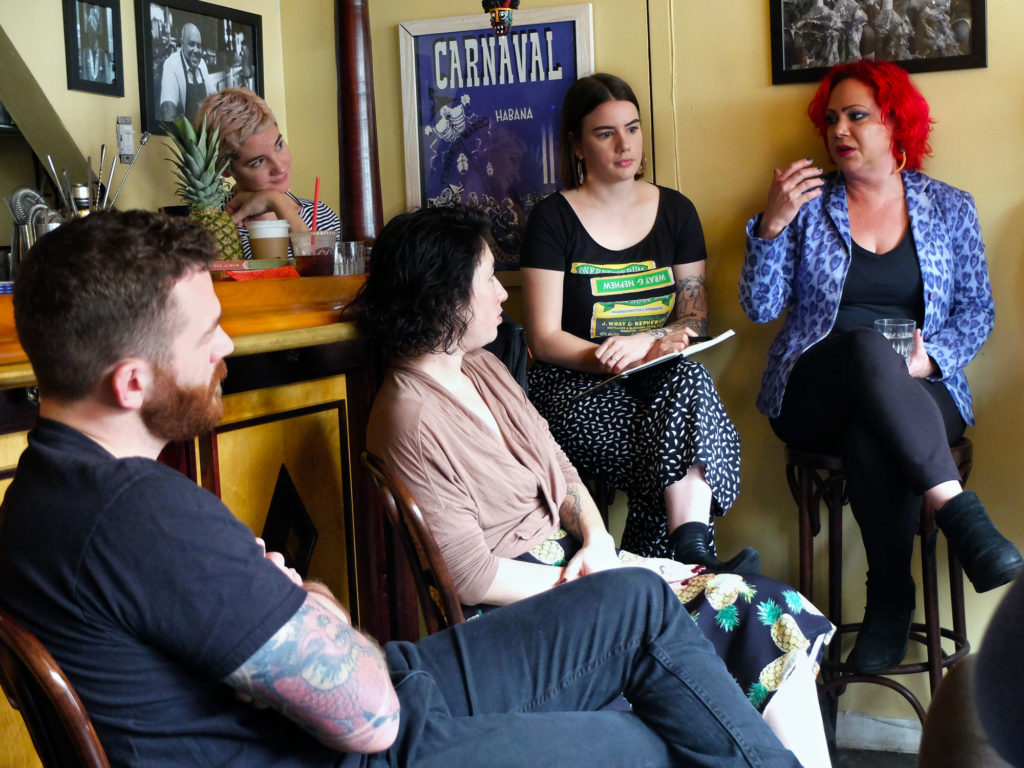
Daiquiri by Josephine Romo
Daiquiri Natural:
2 ounces white rum
¾ ounce lime juice
2 teaspoons granulated sugar
Build the Cantineros de Cuba way:
Stir the ingredients before adding ice to the tin. Add ice and shake vigorously. Throw the cocktail twice and strain into a chilled glass.
Details:
Havana Club 3 year is my favorite because it is forbidden here in the states, but Denizen 3 makes me happy. Granulated sugar creates a better texture over simple syrup and a Nick and Nora is always preferable to a coupe.
Best place to drink a Daiquiri Natural:
At the grave of Constantino Ribalaigua Vert owner of El Floridita and one of the founding members of the Asociación de Cantineros de Cuba.
Lime Time
Nick: What if you were in, say, Central America, and you pull out a key lime as opposed to a Persian?
Wayne: I’m willing to try that.
Nick: Would you call it a Daiquiri?
Wayne: Yeah.
Kimberly: Yeah.
Jen: Yeah.
Nick: 1927 was the citrus epidemic that wiped out key limes. Because they didn’t use Persian limes here until that point. So, all Daiquiris from 1903 to 1927 would have been key limes. So, are we even making Daiquiris then?
Kimberly: We don’t even know. We don’t know what limes in 1903 tasted like. We have different pesticides, we have different agricultural practices. So, we really don’t know. We just know the skeleton, which is the trinity.
Nick: Would you say that the variable is with the citrus, when you have control over the sweetener and the rum?
Maggie: I’ve had people say, “Make your house Daiquiri, just add a little bit of Wray and Nephew.” But I’ve never once had someone at the bar asking me what kinds of limes I have today.
Wayne: That’s a slice of the times. Twenty years ago if you got Daiquiri you would had Bacardí, white sugar, and lime. Now, there’s all these different sugars, there’s all these different rums. I think citrus might catch up at some point, you might be able to select. “What kind of lime would you like with that?”
Maggie: As far as rum bars and rum nerds, I feel like they care more about the rum than anything. “What rum do you have?” Obviously in Manolito we explain why we use the granulated sugar versus simple. But even then people don’t question it, they just taste it and they’re like, “Oh, this is delicious.” And then maybe they ask what you did differently, why does this Daiquiri taste different than any other Daiquiri I’ve had before? And then you explain it. But it’s always more of a rum conversation than anything about that.
Daiquiri by Maggie Morgan
My ideal Daiquiri. Oh boy. First of all, you must use an unaged rum OR an aged rum that has been charcoal filtered. To me this is the litmus test for every unaged/filtered rum out there. Does it make a good Daiquiri? Then it’s a good product. While I have no qualms with using aged rum in a Daiquiri (I absolutely love a Smith and Cross Daiquiri from time to time), I personally want my Daiquiris crisp and clean and to the point. Aged rums sometimes overpower the overall experience. But, as always, it depends on what rum you are using. My absolute favorite Daiquiri rum is the Flor de Caña 4 Year Extra Seco. To me, it’s the perfect Daiquiri rum. Smooth, clean, dry. When added with lime and sugar it truly is a holy trinity of crisp, tart, and refreshing—everything a Daiquiri should be. I also prefer to use granulated sugar in place of simple syrup as simple syrup already has water. If you’re using a 1:1 syrup once you add ice you can get an over-diluted drink. On the other hand, when using a 2:1 syrup the drink can become too syrupy instead of being nice and light.
As far as setting, a Daiquiri will make any time and place better. I have no preference. If I’m romanticizing, however, I would obviously choose to be on the beach in Daiquiri, Cuba. Maybe the sun is about to set, I spent the day wandering the streets, and am grilling a fresh caught fish I picked up at a local market. I can hear Buena Vista Social Club being played somewhere close by. This Daiquiri is one for the books—and a dream I need to make a reality!
All right, now for the spec.
2 ounces Flor de Caña 4 Year Extra Seco
¾ ounce fresh lime juice
2 teaspoons granulated sugar
Add your sugar first, your lime juice, then your rum to a shaker tin.
Take a bar spoon and give it a good stir to help dissolve the sugar crystals.
Add ice and shake hard until the tin is cold.
Pour Daiquiri into a 9 ounce Pasabahce Timeless Coupe. Do not double strain; ice chips are ideal.
No garnish.
Salud!
Nick: So, would you call a drink with like, say, Smith and Cross, lime, and sugar a Daiquiri?
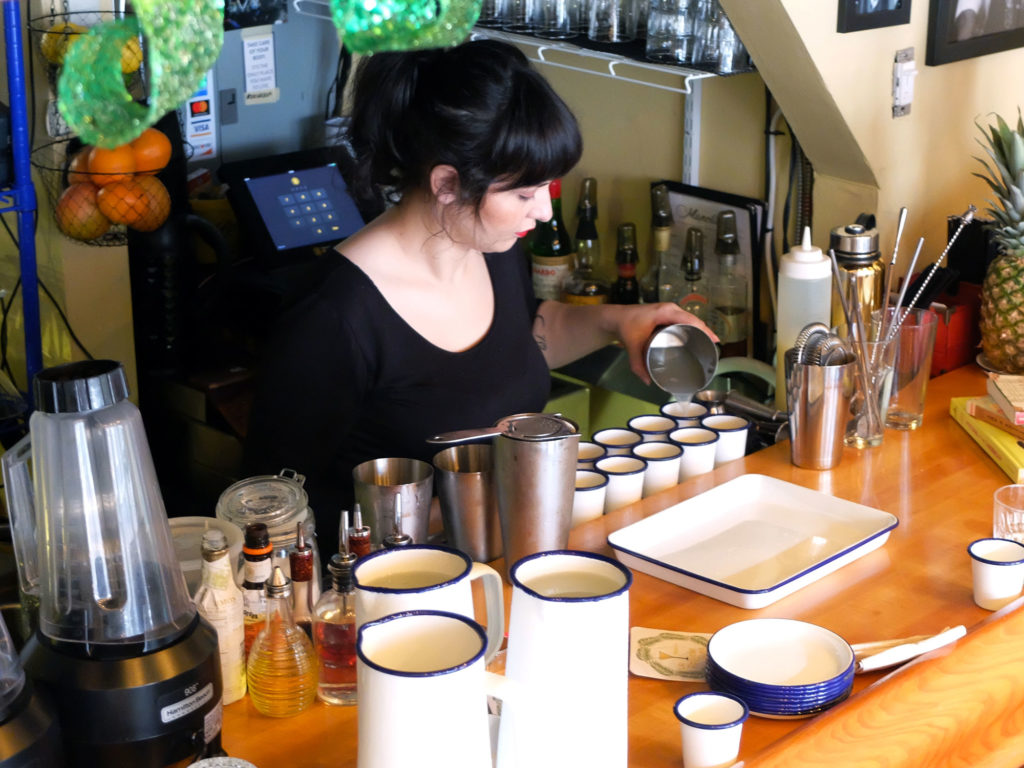
Jeff: I personally would not. I’d call that a Planter’s Punch on a stem. Because a Daiquiri calls for a white Cuban or Spanish style rum, to me. That’s 33% of it right there, that’s the original recipe. If you put Jamaican rum in there, you’ve made a Planter’s Punch. If you put agricole in there, you’ve made a Ti’ Punch. You’re just serving it differently. Again, it just comes down to nomenclature.
Liam: I’d say the lime is the most important part of the Daiquiri. But they’re also the most overlooked. Acidity is the tell tale sign of a Daiquiri.
Jeff: One lime is going to be 180 degrees from another one. One’s going to be total acid burn and the other one is not going to have enough acid in it for your spec. So, if you’re doing a Daiquiri à la minute, squeezing the lime directly into the glass, you just get pot luck, whatever that lime tastes like. But if you’re putting it all into a bottle in the well, you’ll squeeze like twelve limes in there and you’re generally going to even out a little bit more. So, you’re not going to have as much of a consistency problem. I’ve gone from one Daiquiri to another Daiquiri, and thought, “This is the exact same recipe but it’s a totally different drink.”
Nick: Josephine, you juice more limes than anyone here, how much variance would you say that you see from case to case?
Josephine: I would say when I’m making our classic Daiquiris, when I taste the lime juice that we’ve made, it’s probably been sitting for about an hour after I juiced it. I can fluctuate with the spec on lime juice. We use three-quarter spec but you could go less to half or as much as one. Because it changes every day, and if it’s yesterday’s lime juice, you’ve got to change it even more.
It’s really interesting that you can just rely on your sugar and your rum, and then where the creativity comes from is the citrus, always. But that’s what makes it interesting, you know. It keeps you interested and engaged in such a simple drink.
Yesterday’s is oxidized a little bit more. So it’s going to sit flatter on the palate. Almost like iron in your mouth. So, I’m going to use less or try and throw it out.
Wayne: We did a Tales of the Cocktail some years ago with Dave Arnold and Dave Wondrich. We did a blind tasting of two Daiquiris. One made with day-old lime juice and one had been juiced just an hour before. We didn’t tell anyone, and asked which they preferred. About three quarters preferred the fresh but a quarter preferred the oxidized.
Maggie: Or that’s at least what they’re used to.
Nick: Dave Arnold did that same test at the BAR 5-Day course and then at another seminar somewhere in Europe, and what he found was that the five-hour old juice was what everyone preferred in the States. But when he was in Europe where they would squeeze everything to order, everyone preferred the one which was freshly squeezed.
Daiquiri by Jen Hussey
My ideal Daiquiri is a rhum agricole Daiquiri using Neisson Élevé Sous Bois with a 2:3/4:1/2 proportion, poolside with friends on a lazy day.
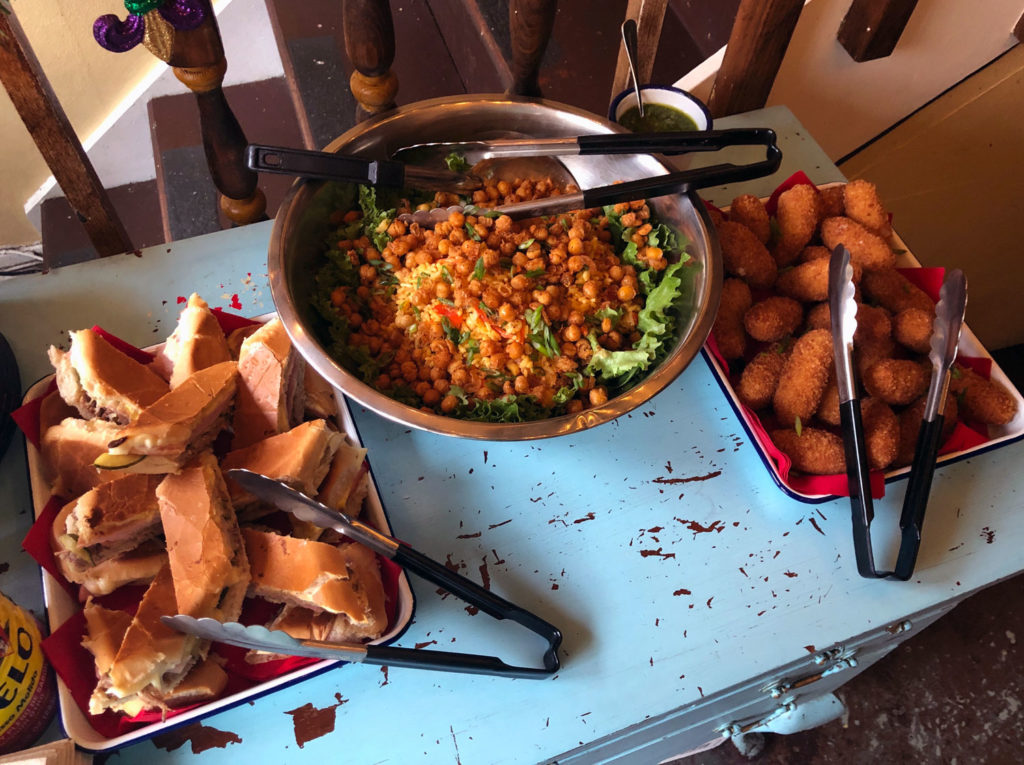
Mind Melt
Nick: Now, a couple of you have mentioned that you would like to use darker syrup with a darker rum.
Kimberly: No, just the opposite.
Nick: Did anyone mention that?
Maggie: No, I said the opposite.
Liam: I might have said that. In my mind it just made sense, I guess. But if you want that richer, darker flavor then I think it makes sense to add sugar that can help it along. So, I guess it might not make sense but maybe in my mind, it’s just…
Kimberly: And I guess why we’re doing this symposium is because it is very personal. Everybody does have their own taste. [Customers] ask me, “What do you like?” I’m like, “Well, we just met. I’m not in your mouth. I don’t know….”
Jen: I’m not your mouth troll.
Kimberly: Exactly! I can’t do the Vulcan mind meld and know exactly what you like. But this is the spec that we do.
Nick: Kim, how much does your Daiquiri spec vary based on guests that you know the preferences of?
Kimberly: Well, it’s always got to be the spec of where I am, and then if they want to do something different then I can always adjust. At home I’ll do either just a classic white rum Daiquiri or I’ll split it up with some agricole. Sometimes I’ll be like, “Fuck it, let’s go white trash and get those party lime concentrate things and stick it in there just for fun.” I mean, it’s garbage but it still takes you back to high school. If you want to do that, great, I want to remember throwing up when I was fifteen. Then we have the right can for you.
Jeff: I think that I might be a little too dogmatic about all this, but it depends on how you approach it. If you approach it as a cocktail writer, or as a cocktail historian, or as cocktail academic or whatever, then I think it has to keep these definitions of a Daiquiri straight. If you are approaching it as drinker or bartender it seems silly to take it that far.
Nick: Well, to that end, let me ask you as the writers in the room, at what point does that start to inhibit how you order drinks—or benefit it?
Jeff: Well, that’s a good question. I always throw myself at the mercy of whatever bar I’m at. If I order a Daiquiri at the bar, I’m just going to get their spec. I’m not gonna be that guy. If I want to drink a drink exactly the way I want it, then I’ll just drink it at home. I want to see what they’re doing.
But speaking to your question, I don’t think it’s necessarily limited me. I think definitions and categories can be good. But what was it that Godard said about films, when it’s a sunny day and you can only shoot in one direction with all these telephone wires over there, you’re forced to do the shot this way and to make it the best you can. And hell, to him, is an evenly overcast day with a clear field of vision, 360 degrees—like, how do I do this? It helps to have the category narrowcasting to the point where you can just be in the zone that the drink wants you to be in.
Wayne: I’d much rather just try what they think is a Daiquiri, and I can silently pass judgment on them. Because it’s educational, and so many of the bar menus now give you all the information on there. You’re mixing a Trinidad and a Martinique rum. I’ll try that. I don’t care what you call it.
Jeff: They give you fair warning.
Kimberly: There was a New York food writer, I can’t remember his name, and he came to a couple bars I worked in in New York, and each time he would give a card—
Jeff: Oh, that guy!
Kimberly: Yeah, what’s his fuckin’ name?
Jeff: He’s been here!
Kimberly: Yeah, he has a card with the spec of his personal Daiquiri. I remember being at Blue Smoke and first getting his card. And first of all, you’re a fucking food writer, aren’t you supposed to be a little bit more subtle than that? But also, if you’re just saying white rum, teaspoon of this, teaspoon of that, who knows what fucking white rum is in their well? I was hoping he was doing it to see if the bartender’s paying attention to the way that they wanted. But this is also, you know, the poor soul at the table is coming over to the bartender—[elaborate sigh]—you know? And then, you know—[more elaborate sigh]—behind the bar too, and that just drove me crazy. I mean who puts on their goddamn business card their own personal spec?
Daiquiri by Kimberly Patton-Bragg
Fantasy-wise, I would love to make a Daiquiri going through Professor Remsberg’s famous library of rare rums. I mean, for research.
Right now, I’m a big fan of a blend of Worthy Park and Neisson Élevé Sous Bois.
I do prefer it in a chilled coupe. Starting with 2 teaspoon of Demerara sugar and 1 ounce of fresh lime, stirring until dissolved, and then add 1 ounce each of the Worthy Park and Neisson. Shake with cracked ice or one-inch cubes and strain into coupe.
Ideally, I would love to enjoy it while watching the twilight in my favorite place in the world, Aix-en-Provence. Green and cobalt are my favorite color combo, and the twilight sky in Aix is impossibly blue, and the trees are super green. A matching cocktail only makes sense.
Jen: Some people have asked me for a rum gimlet before. And I’m like, “You got it, babe.”
Nick: I was stumped when I got that order. Liam, do you think that Daiquiri semantics can get problematic for you as a bartender or your guests in ordering drinks?
Liam: I don’t think so. If people ask for a Daiquiri, you know they want rum, lime, and sugar. You need the time and the patience in order to have conversations with someone about what they really want. That’s totally different. I think the rules of what makes a Daiquiri by definition are different than what someone wants to drink that day.
Maggie: As a bartender, whoever comes in your door, it is your job to make the drink that they want. We can argue about semantics all day, but what makes this person happy is the most important thing. And I love that we’re having this conversation about Daiquiris and what we love, but something that’s special is that every single one of us had a different answer to what our perfect Daiquiri is. And that’s kind of what’s beautiful about bartending.
Jen: I trust my guests—for the most part. If it’s someone sitting at a table and they want a sweeter Daiquiri, I’m going to trust that they will have communicated that to the server. And some do, some don’t, but I’m going to first go with my house spec, and then trust that. If it’s someone who really knows what they’re looking for, they’ll communicate it back. But most of those people who are going to get into the semantics, most of them aren’t going to sit at a table. They’re going to sit at the bar and they’re going to have started a conversation with me already.
Now, one of my biggest things is if someone walks in off the street and they order a Daiquiri, I first want to figure out if they are expecting a blended drink, like out of a machine? Or are they expecting your shaken rum, lime, simple drink? And then you go from there.
Maggie: I think in New Orleans it’s a little trickier to maneuver the Daiquiri conversation than any other city. Absolutely.
Jeff: I think if you just put a modifier in front of the word Daiquiri, or whatever you’re doing with it, then you’re cool.
There’s something that occurred to me while we’ve been talking, and the Planter’s Punch came up. The Planter’s Punch is a drink that over time has morphed from a cocktail to a cocktail category. You can go get a Planter’s Punch ten different places, and they’ll have ten different juices, and ten different things. And it’s just all over the place.
I think I’m slowly starting to realize, just today, in this room having this conversation, that the Daiquiri is—actually I have to reverse myself—it’s a drink category now, really. Because there are so many variations. Just the stuff we talked about in the last hour. Really the Daiquiri is more a drink category than a drink.

Nick: So you think that the 2020s will see the Daiquiri list instead of the 1990s Martini list?
Jeff: Yeah! That already exists.
Maggie: Like a Daiquiri buffet, or a build-your-own Daiquiri on menus where it lets you select, tier one, what sugar you want. Tier two, what lime juice you want, then tier three, it has twenty different rums, and it’s like a D.I.Y. Daiquiri. A salad bar Daiquiri. I feel like that’s the future of the Daiquiri, where we’re going, because there are so many different preferences and it’s such a hard discussion.
Jeff: In a way, like back to the ’70s. Strawberry Daiquiri, lime Daiquiri, like that.
Daiquiri by Wayne Curtis
The lime: Pick a lime off the tree next to the pool. Select a lime that’s plump, soft to the touch, and with a thin skin. Cut in half, and squeeze one half into a cocktail shaker.
The sugar: Add Demerara syrup (1:1). Use slightly less than the lime juice. (E.g, if the half-lime yields a half-ounce, use one-third ounce of simple.)
The rum: Add 2 ounces rum: crisp and bright rum preferred. My current favorite is the Manolito blend that mimics Cuban rum: 6 parts El Dorado 3 year; 3 parts Caña Brava white; 1 part Smith and Cross.
The crux move: Add 2–3 leaves from the lime tree into the shaker.
Shake with vigor until well chilled. Strain into coupe. Garnish with lime leaf.
Wayne: We should’ve had David Ervin here too. Because he invented the drive-through Daiquiri stand out in Lafayette. He’s the one that gave the name to just frozen, blended drinks: the Daiquiri. But it sounds like a cool name. He thought of calling them Frozen Collins and other things. And he picked Daiquiri because he thought it was a good name.
Nick: How different then is that Daiquiri from the Daiquiris we’ve been talking about?
Wayne: Well, start with neutral grain spirits.
Nick: Was it even intended to taste like a Daiquiri?
Wayne: No, it’s just a frozen drink. He was copying a guy down the street from him who had a takeout stand. People had to park, go in, get their blended, frozen drinks. He goes, “I can make this more efficient.” So he opened up a half mile up the street with a drive-through lot. Lafayette tried to shut him down several times but he always—he’s the one that invented putting a piece of masking tape over the hole in the cup. And it went through court and it was considered a sealed container. It was legal.
He’s well known for creating the drive-through Daiquiri stand, that’s interesting, but I’m also fascinated about creating a category. All those Daiquiri machines are because of him.
Maggie: I think that is something that is special to New Orleans, the New Orleans Daiquiri is a singular thing. When we make our Daiquiris fresh here in a blender, we’re trying to explain that this is a Cuban style, this is a Cuban Daiquiri, not the New Orleans Daiquiri. We kind of have to walk through that.
Nick: The Daiquiri, in its name, was still very young when Constante introduced the blender to El Floridita. So is that problematic to the Daiquiri?
Maggie: Wasn’t Constante making those pre-blender anyway, like he was just shaking them with shaved ice for a really long time, or throwing them?
Nick: They were shaken, they were thrown, they were frappéed.
Maggie: I feel like even the original Floridita has evolved and developed with the technology.
Nick: Josephine, you were just in Cuba last month, what was your experience with ordering Daiquiris while in Havana?
Josephine: We actually never got a chance to. They see [Chris] Hannah and just hand us drinks.
No, it was a delight. Absolutely. To roll into El Floridita, with such calamity in there, and to have them hand us these little gems.
Jen: Were they serving you Floriditas?
Josephine: Absolutely, always Floriditas. They were always frozen.
Nick: It’s too bad you can’t go to the Daiquirí Beach anymore.
Jeff: You can’t?
Nick: No, it’s a Cuban army R&R place now. When we went, we went to the gates and there’s like a little tree out there, we just made Daiquiris outside the gates while tanks were rolling in. It’s over some hills before you get to the beach. So you’re a good distance away from it.
Maggie: That’s sad.
Liam: You’ll have to join the Cuban military.
FIN.
Daiquiri by Nick Detrich
A Daiquiri at the Floridita, hand shaken by Chris Hannah with Havana Club 3, lime, granulated sugar.
